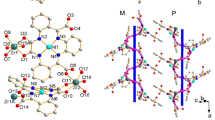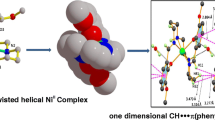Abstract
Two helical one-dimensional complexes [MnII(MeOH)4][MnIV(L·)2]·2MeOH (1) and [MnIII(salen)][MnIII(L)2] (2) (H2L = HON=C(Ph)N=NC6H4CO2H) contain the noninnocent ligand [Mn(L·)2]2− and innocent low-spin [Mn(L)2]−. Intrachain antiferromagnetic interaction between adjacent manganese ions via the syn-anti carboxylate bridges in complex 1. Alternate syn-anti and anti-anti carboxylate bridges have been found to transmit ferro- and antiferromagnetic coupling between high-spin and low-spin Mn(III) ions in complex 2.
Similar content being viewed by others
References
Sun HL, Wang ZM, Gao S. Strategies towards single-chain magnets. Coord Chem Rev, 2010, 254: 1081–1100
Bagai R, Christou G. The Drosophila of single-molecule magnetism: [Mn12O12(O2CR)16(H2O)4]. Chem Soc Rev, 2009, 38: 1011–1026
Brechin EK. Using tripodal alcohols to build high-spin molecules and single-molecule magnets. Chem Commun, 2005: 5141–5153
Rebilly JN, Mallah T. Synthesis of single-molecule magnets using metallocyanates. Struct Bond, 2006, 122: 103–131
Miyasaka H, Saitoh A, Abe S. Magnetic assemblies based on Mn(III) salen analogues. Coord Chem Rev, 2007, 251: 2622–2664
Wang CF, Zuo JL, Bartlett BM, Song Y, Long JR, You XZ. Symmetry-based magnetic anisotropy in the trigonal bipyramidal cluster [Tp2(Me3tacn)3Cu3Fe2(CN)6]4+. J Am Chem Soc, 2006, 128: 7162–7163
Palii A, Ostrovsky SM, Klokishner SI, Tsukerblat BS, Dunbar KR. Highly anisotropic orbitally dependent superexchange in cyanobridged clusters containing Mn(III) and Mn(II) ions. ChemPhysChem, 2006, 7: 871–879
Berlinguette CP, Vaughn D, Canada-Vilalta C, Galan-Mascaros JR, Dunbar KR. A trigonal-bipyramidal cyanide cluster with singlemolecule-magnet behavior: Synthesis, structure, and magnetic properties of {[MnII(tmphen)2]3[MnIII(CN)6]2}. Angew Chem Int Ed, 2003, 42: 1523–1526; Yan B, Chen Z, Wang S, Gao S. A novel onedimensional chain cyano-bridged complex [Sm(DMF)4(H2O)2Mn-(CN)6·H2O]n: Long-range magnetic ordering, Tc = 18 K and coercive force Hc = 600 Oe. Chem Lett, 2001: 350–351
Tang M, Li D, Mallik UP, Withers JR, Brauer S, Rhodes MR, Clerac R, Yee GT, Whangbo MH, Holmes SM. First structurally characterized tricyanomanganate(III) and its magnetic {MnIII 2MII 2} complexes (MII = Mn, Ni). Inorg Chem, 2010, 49: 4753–4755; Matsuda M, Yamaura JI, Tajima H, Inabe T. Structure and magnetic properties of a low-spin manganese(III) phthalocyanine dicyanide complex. Chem Lett, 2005, 34: 1524–1525
Ganguly S, Karmakar S, Chakravoty A. First examples of carboxyl-bonded low-spin manganese(III) complexes. Inorg Chem, 1997, 36: 116–118
Ni ZH, Zheng L, Zhang LF, Cui AL, Ni WW, Zhao CC, Kou HZ. Cyanido-bridged dimetallic complexes derived from manganese( III) Schiff bases and pentacyanidonitrosylchromate(I): Synthesis, crystal structures and magnetic properties. Eur J Inorg Chem, 2007: 1240–1250
Shivakumar M, Pramanik K, Ghosh P, Chakravorty A. Isolation and structure of the first azo anion radical complexes of ruthenium. Inorg Chem, 1998, 37: 5968–5969
Brown DB. On the effective charge of iron in nitroprusside. Inorg Chim Acta, 1971, 5: 314–316
Muresan N, Chlopek K, Weyhermuller T, Neese F, Wieghardt K. Bis(α-diimine)nickel complexes: Molecular and electronic structure of three members of the electron-transfer series [Ni(L)2]z (z = 0, 1+, 2+) (L = 2-phenyl-1,4-bis(isopropyl)-1,4-diazabutadiene). A combined experimental and theoretical study. Inorg Chem, 2007, 46: 5327–5337
Verdaguer M, Gleizes A, Renard JP, Seiden J. Susceptibility and magnetization of CuMn(S2C2O2)2·7.5H2O. First experimental and theoretical characterization of a quasi-one-dimensional ferrimagnetic chain. Phys Rev, 1984, B29: 5144–5155
Borrás-Almenar JJ, Clemente-Juan JM, Coronado E, Tsukerblat BS. MAGPACK1 A package to calculate the energy levels, bulk magnetic properties, and inelastic neutron scattering spectra of high nuclearity spin clusters. J Comput Chem, 2001, 22: 985–991
Wang XY, Wang ZM, Gao S. Constructing magnetic molecular solids by employing three-atom ligands as bridges. Chem Commun, 2008, 281–294; Bai YL, Tao J, Wernsdorfer W, Sato O, Huang RB, Zheng LS. Coexistence of magnetization relaxation and dielectric re laxation in a single-chain magnet. J Am Chem Soc, 2006, 128: 16428–16429; Xu HB, Wang BW, Pan F, Wang ZM, Gao S. Stringing oxo-centered trinuclear [MnIII 3O] units into single-chain magnets with formate or azide linkers. Angew Chem Int Ed, 2007, 46: 7388–7392; Liu CM, Zhang DQ, Zhu DB. 1D coordination polymers constructed from anti-anti carboxylato-bridged MnIII 3O(Brppz)3 units: From long-range magnetic ordering to single-chain magnet behaviors. Inorg Chem, 2009, 48: 4980–4987
Chaudhuri P. Homo- and hetero-polymetallic exchange coupled metal-oximates. Coord Chem Rev, 2003, 243: 143–190; Milios CJ, Stamatatos TC, Perlepes SP. The coordination chemistry of pyridyl oximes. Polyhedron, 2006, 25: 134–194; An GY, Ji CM, Cui AL, Kou HZ. Pyrazine-2-amidoxime Ni(II) complexes: From ferromagnetic cluster to antiferromagnetic layer. Inorg Chem, 2011, 50: 1079–1083
Wu L, Xue M, Huang L, Qiu SL. Hydrothermal synthesis, structure, fluorescence property of a novel 3D metal-organic framework with high thermal stability. Sci China Chem, 2011, 54: 1441–1445; Wang RH, Zhou YF, Sun YQ, Yuan DQ, Han L, Lou BY, Wu BL, Hong MC. Syntheses and crystal structures of copper(II) coordination polymers comprising discrete helical chains. Cryst Growth Des, 2005, 5: 251–256; Ranford JD, Vittal JJ, Wu D, Yang X. Thermal conversion of a helical coil into a three-dimensional chiral frame work. Angew Chem Int Ed, 1999, 38: 3498–3501
Author information
Authors and Affiliations
Corresponding author
Electronic supplementary material
Rights and permissions
About this article
Cite this article
Kou, H., Zhang, Y. & Cui, A. Carboxylate-bridged helical chains based on an azo carboxylate oximate ligand. Sci. China Chem. 55, 1042–1046 (2012). https://doi.org/10.1007/s11426-012-4550-9
Received:
Accepted:
Published:
Issue Date:
DOI: https://doi.org/10.1007/s11426-012-4550-9




